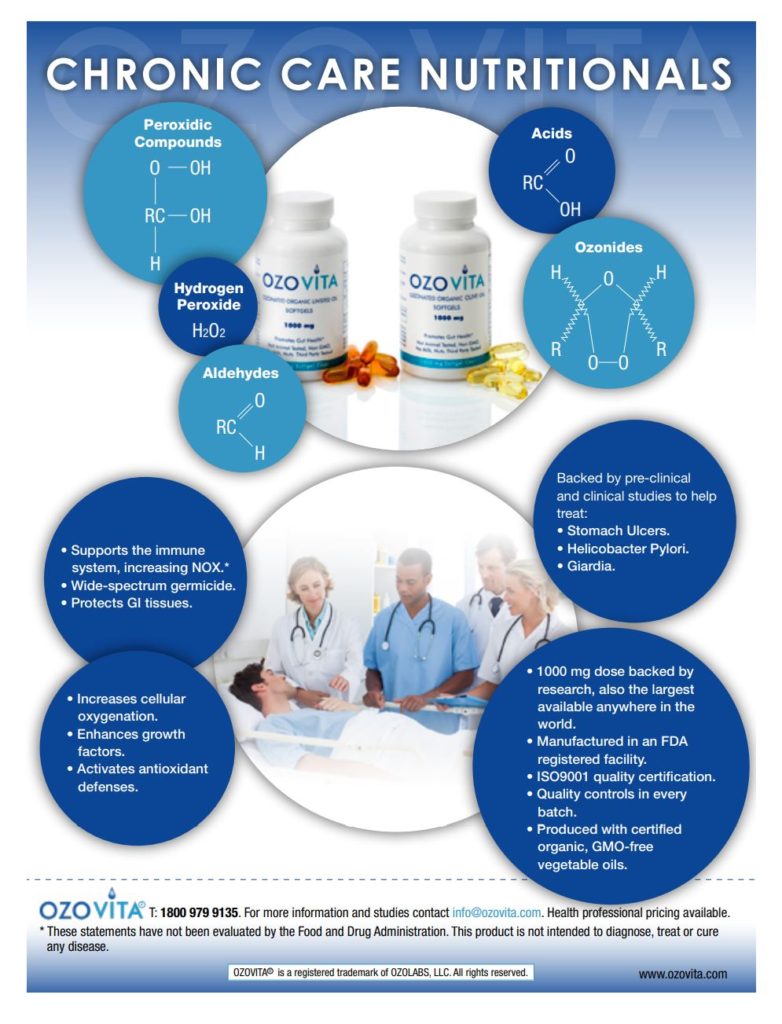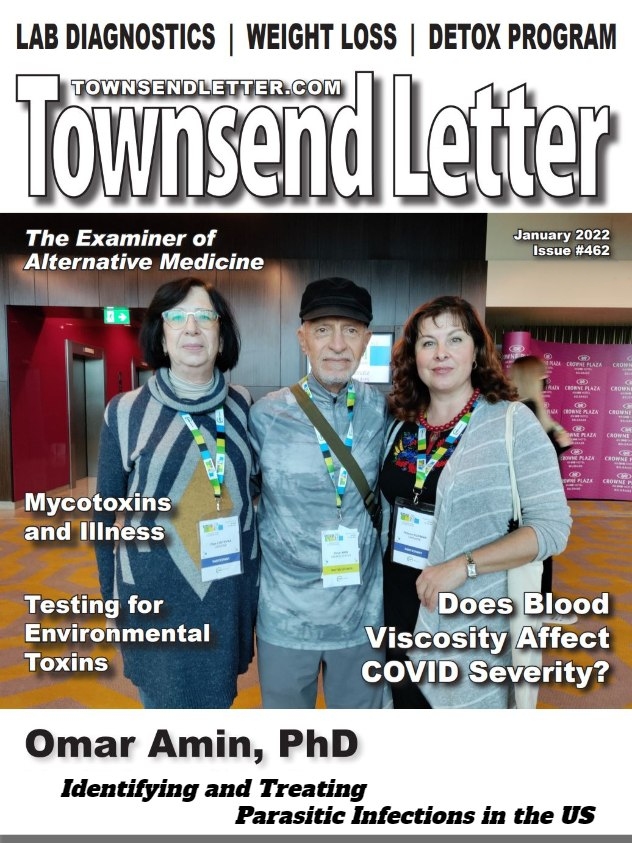By Andrea Gruszecki, ND
We live in a toxic world, and today is the least toxic day of the rest of our lives.1 Ultimately, our health is the result of genetics, nutritional status and environmental exposures. The World Health Organization has estimated that up to 22% of the global burden of disease may be due to preventable environmental influences.2
Toxic exposures begin in the womb and can affect developmental programming of the fetus.3 Prenatal exposures can affect not only perinatal birth risks, but the lifetime risk of disease. These early exposures can affect fertility and hormone function, adrenal function, immune system responses, and cognitive functions.4-6 Throughout life, continued bioaccumulation adds to the toxic burden and may exacerbate these functions, which can result in chronic health problems.7
In addition to the “usual” environmental exposures (which include air pollution, preservatives, additives used in foods, household products and body-care products), the practice of fracking has created a significant new source of chemical exposure.8,9 The fracking process contaminates fresh water with a variety of chemicals, and the used wastewater can contaminate groundwater supplies.10 A variety of chemicals may be found in fracking wastewater, including xylenes, toluene, benzene, styrene, etc.9 Other significant sources of groundwater contamination include agriculture, industrial/commercial processes, and municipal or residential waste disposal practices.11 Municipal water sources are monitored for common contaminants, but private wells are not; this leaves a significant portion of the population vulnerable to water contamination.12 If contaminated water is used for agriculture, then chemicals that bioaccumulate into the food chain become an additional source of exposure through food.13,14

Toxic exposures and genetic diversity, combined with the inflammatory components and common nutritional deficiencies of the standard Western diet, are a “perfect storm” of proinflammatory influences on humans.15,16 If the level of toxic exposure is greater than the individual’s capacity to rapidly detoxify, a lipophilic chemical can migrate into adipose cells or into the mitochondria.17 Mitochondrial sequestration is particularly problematic because the mitochondria may be unable to completely detoxify the chemical or export it to the cytoplasm for further detoxification.18,19 If this happens, the mitochondria are eventually poisoned by the chemicals trapped within their membranes.
Ongoing chemical exposures can disrupt a variety of biochemical signaling pathways and cellular functions.8 Toluene, phthalates, and benzene can cause inflammation; and other chemical exposures can contribute to atopic diseases (allergy, asthma, eczema). Exposure to lipophilic chemicals such as phthalates, combined with other types of toxic exposure, may increase the risk of type II diabetes.20 Inexplicably, the effects of chemical exposures on the adrenal glands and hypothalamus-pituitary-adrenal axis are not considered by regulatory agencies prior to establishing “safe” exposure doses.21 These described health effects are compounded by the fact that chemicals and other toxicants are evaluated individually for potential harm, when in fact combinations of pollutants have far greater effect at much lower doses.22,23 This makes screening for background exposures from vehicle exhaust, household products, body products, and food/water an important step in any medical evaluation (See Figure 1).7

exposures may be an essential step in any clinical
evaluation. This 49-yo woman had unknown exposures
to toluene, benzene, styrene, phthalates, parabens,
and the gasoline additive MTBE.
If an illness or disorder can be the end-result of toxic exposure, poor nutrition, and perhaps the genetic inheritance of one or more low-activity enzyme variants, then what is a clinician to do?
Taking certain steps, in the correct order, can go far to assist the body to detoxify itself:7,24,25
- Identify and remove sources of ongoing toxic exposures (Figure 1). In addition to toxic chemicals, toxic metals must also be evaluated and detoxified; that process is beyond the scope of this article, and the interested reader is referred to a review by Sears (2013).26
- Evaluate and support primary biochemical pathways and mitochondrial function. Adequate mitochondrial function is required for phase III export into bloodstream (excretion via renal filtration and urine) or bile.
- Normalize the function of all organs of elimination, including all three phases of liver detoxification, and support with proper nutrition.
- Encourage sweating to increase the rate of chemical detoxification through the skin.
Once the toxic exposures have been identified and removed from the environment, the detoxification of recent and bioaccumulated exposures can be undertaken. The evaluation of primary biochemical pathways and mitochondrial function should be undertaken early in the process to provide a baseline study; ideally the patient is free of supplements for several weeks prior to the assessment so that native function can be evaluated and supported (See Figure 2).

chemicals such as phthalates, xylene, and parabens. Exposures to toxic metals such as arsenic may also be apparent in the pattern of results.
An Organic Acids profile can assess primary biochemical pathways and the body’s use of dietary carbohydrates, proteins, and fats. In Figure 2, certain patterns reflect not only possible toxic exposures and a problem in the mitochondrial citric acid cycle, but also a possible insulin-glucose dysregulation that may complicate the patient’s treatment:27,28
Toxic exposures that may be reflected in the Organic Acids results include the following:
- Arsenic: high pyruvate/low citrate, low pyroglutamate
- Benzoate: increased benzoate:hippurate ratio
- Parabens: high parahydroxybenzoate level
- Phthalates: high pyruvate/low lactate, increased adipate, suberate, lower para-hydroxyphenyllactate, increased quinolinate:kynurenate ratio
Results that may indicate metabolic syndrome or type II diabetes include the following:
- Increased adipate, suberate, ethylmalonate, methylsuccinate, alpha-ketoisovalerate, alpha-ketoisocaproate, alpha-keto-beta-methylvalerate, beta-hydroxyisovalerate, alpha-hydroxybutyrate, beta-hydroxybutyrate, 5-hydroxyindoleacetate
- Suppression of alpha-ketoglutarate, pyroglutamate
Adjustment of dietary intakes and nutritional supports can facilitate the function of mitochondria, primary biochemistry, and detoxification pathways, all of which are also likely to improve glucose-insulin regulation.25,29,30
Once the patient’s diet and lifestyle have been adjusted to correct any imbalances associated with comorbid medical disorders, such as the metabolic syndrome indicated above, detoxification of the patient may begin. After necessary testing to confirm the presence of toxic chemicals or metals, the following steps may be taken to support detoxification of the patient8,31:

- Eliminate the toxic exposures
- The removal of toxic metals from the body is beyond the scope of this article; interested readers are referred to Sears (2013).26
- Adjust diet and lifestyle
- Evaluate and support gastrointestinal motility and microbiome diversity.
- A diverse gut microbiome can perform many biochemical detoxification processes. Support microbiome diversity with a diet rich in fiber, fruits and vegetables.32,33
- Do not attempt detoxification until the patient is free of constipation or other slow/low motility disorders.
- Ensure adequate hydration to support kidney function.
- Engage in regular exercise or sauna to induce sweating.
- Evaluate and support gastrointestinal motility and microbiome diversity.
- Detoxification25,34
- Ideally, the results report for any chemical or metals assessment includes specific detoxification suggestions for each analyte (See Figure 3).
- Nutritional support of liver Phase I and II
- Nutrients that may support phase I include selenium, zinc, and vitamins A, B2, B3, C, D, E, and K. Plant compounds, such as sulforaphane found in broccoli and other Brassica family vegetables also support detoxification.
- Nutrients that may support phase II include reduced glutathione or N-acetyl cysteine (glutathione precursor), B vitamins and calcium-D-glucarate.
- Nutritional support for mitochondria for Phase III export
- Organic Acids results for Citric Acid Cycle metabolites can be used to customize mitochondrial nutritional support.
- Antioxidant status
- Antioxidant status is primarily determined by glutathione levels.
- Increased levels of the Organic Acids analytes methylmalonate, quinolinate and pyroglutamate, with decreased levels of cis-aconitate and isocitrate, may indicate poor antioxidant status.35,36

support nutrients for detoxification pathways facilitates the removal of
toxic chemicals from the body. Chart used with permission (Gruszecki 2021).
In conclusion, while we live in a world full of toxic chemicals and metals, it is important to remember that there are other types of “toxic exposures” to contend with on a daily basis.23 The most important of these other exposures are likely to be daily psychological effects and the after-effects of traumatic experiences, both of which can increase inflammation and shift biochemical functions.37,38 Complete detoxification on all levels of being may be required to achieve and maintain a patient’s desired health status.7
References
- Naidu R, et al. Chemical pollution: A growing peril and potential catastrophic risk to humanity. Environ Int. 2021 May 12;156:106616.
- Prüss-Ustün A, et al. Diseases due to unhealthy environments: an updated estimate of the global burden of disease attributable to environmental determinants of health. J Public Health (Oxf). 2017 Sep 1;39(3):464-475.
- Bansal A, Henao-Mejia J, Simmons RA. Immune System: An Emerging Player in Mediating Effects of Endocrine Disruptors on Metabolic Health. Endocrinology. 2018 Jan 1;159(1):32-45.
- Harvey PW, Everett DJ, Springall CJ. Adrenal toxicology: a strategy for assessment of functional toxicity to the adrenal cortex and steroidogenesis. J Appl Toxicol. 2007 Mar-Apr;27(2):103-15.
- Liu J, Lewis G. Environmental toxicity and poor cognitive outcomes in children and adults. J Environ Health. 2014 Jan-Feb;76(6):130-8.
- Street ME, Bernasconi S. Endocrine-Disrupting Chemicals in Human Fetal Growth. Int J Mol Sci. 2020 Feb 20;21(4):1430.
- Sears M, Genuis S. Environmental Determinants of Chronic Disease and Medical Approaches: Recognition, Avoidance, Supportive Therapy, and Detoxification. J Environ Public Health. 2012; 2012: 356798.
- Genuis SJ, Kyrillos E. The chemical disruption of human metabolism. Toxicol Mech Methods. 2017 Sep;27(7):477-500.
- Nagel SC, et al. Developmental exposure to a mixture of unconventional oil and gas chemicals: A review of experimental effects on adult health, behavior, and disease. Mol Cell Endocrinol. 2020 Aug 1; 513: 110722.
- DiGiulio D, Jackson R. Impact to Underground Sources of Drinking Water and Domestic Wells from Production Well Stimulation and Completion Practices in the Pavillion, Wyoming, Field. Environ Sci Technol. 2016;50(8):4524–4536.
- United States Environmental Protection Agency. Getting Up to Speed: Ground Water Contamination. Excerpt from US EPA Seminar Publication. Wellhead Protection: A Guide for Small Communities. Chapter 3. EPA/625/R-93/002. https://www.epa.gov/sites/default/files/2015-08/documents/mgwc-gwc1.pdf Accessed 16 August 2021.
- United States Environmental Protection Agency. (2021) Potential Well Water Contaminants and Their Impacts. https://www.epa.gov/privatewells/potential-well-water-contaminants-and-their-impacts Accessed 16 August 2021.
- Arnot JA, Gobas FA. A food web bioaccumulation model for organic chemicals in aquatic ecosystems. Environ Toxicol Chem. 2004 Oct;23(10):2343-55.
- McLachlan M. Bioaccumulation of Hydrophobic Chemicals in Agricultural Food Chains. Environ Sci Technol. 1995;30(1):252–259.
- Mohrenweiser HW. Genetic variation and exposure related risk estimation: will toxicology enter a new era? DNA repair and cancer as a paradigm. Toxicol Pathol. 2004 Mar-Apr;32 Suppl 1:136-45.
- Tiffon C. The Impact of Nutrition and Environmental Epigenetics on Human Health and Disease. Int J Mol Sci. 2018 Nov 1;19(11):3425.
- Jackson E, et al. Adipose Tissue as a Site of Toxin Accumulation. Compr Physiol. 2017 Sep 12;7(4):1085-1135.
- Liska D, Lyon M, Jones DS. Detoxification and biotransformational imbalances. Explore (NY). 2006 Mar;2(2):122-40.
- Zolkipli-Cunningham Z, Falk M. Clinical effects of chemical exposures on mitochondrial function. Toxicology. 2017 Nov 1;391:90–99.
- Zeliger HI. Lipophilic chemical exposure as a cause of type 2 diabetes (T2D). Rev Environ Health. 2013;28(1):9-20.
- Martinez-Arguelles DB, Papadopoulos V. Mechanisms mediating environmental chemical-induced endocrine disruption in the adrenal gland. Front Endocrinol (Lausanne). 2015 Mar 4;6:29.
- Kortenkamp A, et al. Low-level exposure to multiple chemicals: reason for human health concerns? Environ Health Perspect. 2007 Dec;115 Suppl 1(Suppl 1):106-14.
- Rider CV, et al. Cumulative risk: toxicity and interactions of physical and chemical stressors. Toxicol Sci. 2014 Jan;137(1):3-11.
- Genuis SJ, et al. Blood, urine, and sweat (BUS) study: monitoring and elimination of bioaccumulated toxic elements. Arch Environ Contam Toxicol. 2011 Aug;61(2):344-57.
- Hodges RE, Minich DM. Modulation of Metabolic Detoxification Pathways Using Foods and Food-Derived Components: A Scientific Review with Clinical Application. J Nutr Metab. 2015;2015:760689.
- Sears ME. Chelation: harnessing and enhancing heavy metal detoxification–a review. ScientificWorldJournal. 2013 Apr 18;2013:219840.
- Jiang S, et al. Diabetic‑induced alterations in hepatic glucose and lipid metabolism: The role of type 1 and type 2 diabetes mellitus (Review). Mol Med Rep. 2020;22(2):603-611.
- Montgomery MK, Turner N. Mitochondrial dysfunction and insulin resistance: an update. Endocr Connect. 2015;4(1):R1-R15.
- Asif M. The prevention and control the type-2 diabetes by changing lifestyle and dietary pattern. J Educ Health Promot. 2014;3:1.
- Valdés-Ramos R, et al. Vitamins and type 2 diabetes mellitus. Endocr Metab Immune Disord Drug Targets. 2015;15(1):54-63.
- Gruszecki A. (2021) Organic Acids Profile and Environmental Pollutants Interpretation Guide. US BioTek, Shoreline WA.
- Campbell C, et al. Improved metabolic health alters host metabolism in parallel with changes in systemic xeno-metabolites of gut origin. PLoS One. 2014;9(1):e84260.
- Claus SP, Guillou H, Ellero-Simatos S. Erratum: The gut microbiota: a major player in the toxicity of environmental pollutants?. NPJ Biofilms Microbiomes. 2017;3:17001.
- Hanje AJ, et al. The use of selected nutrition supplements and complementary and alternative medicine in liver disease. Nutr Clin Pract. 2006;21(3):255-272.
- Gamarra Y, et al. Pyroglutamic acidosis by glutathione regeneration blockage in critical patients with septic shock. Crit Care. 2019;23(1):162.
- Gevi F, et al Urinary metabolomics of young Italian autistic children supports abnormal tryptophan and purine metabolism. Mol Autism. 2016 Nov 24;7:47.
- Cohen S, et al. Chronic stress, glucocorticoid receptor resistance, inflammation, and disease risk. Proc Natl Acad Sci USA. 2012 Apr 17;109(16):5995-9.
- Danese A, J Lewis S. Psychoneuroimmunology of Early-Life Stress: The Hidden Wounds of Childhood Trauma?. Neuropsychopharmacology. 2017;42(1):99-114.









